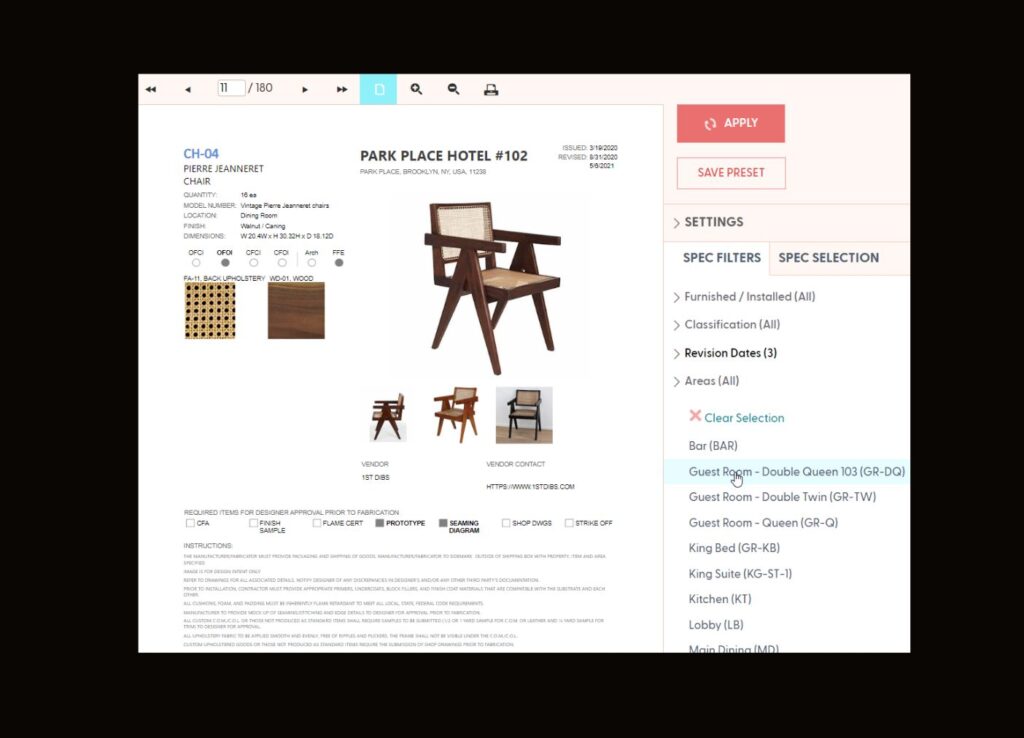For interior designers, specifying furniture is an integral step when executing your design. Finding the right pieces that meet all the criteria required can be tricky. In some instances, the designer will need to find the right existing piece which can be hard enough in itself. Other times, the designer needs to work with a manufacturer to create a bespoke item that has never been done before. In this article, we outline the steps involved in specifying furniture, to help you make informed decisions that align with your clients’ needs and design vision.
Understand the Client’s Requirements:
Before you begin the furniture selection process, it is essential to have a clear understanding of your client’s requirements. Do they require or prefer specific materials and what is your budget? Another question to ask your client is about brand standards; do you have parameters that must be adhered to and what are those? This information will serve as a foundation for your furniture specifications.
Analyze the Space:
Once you have a grasp of your client’s requirements, analyze the space where the furniture will be placed. Consider the dimensions, architectural features, and the overall style and theme of the room. Take note of any existing furniture pieces or design elements that need to be considered when selecting new furniture.
Determine the Functionality:
Identify the purpose and functionality of each space. Is it a hotel lobby that is a high-traffic zone? Or perhaps a busy restaurant with limited space. Understanding the primary use of the room will help you select furniture pieces that align with its intended function.


Establish the Design Style:
Work closely with your client to establish the desired design style for the space. Whether it’s modern, traditional, minimalist, or eclectic, the furniture should reflect the overall design aesthetic. Consider factors such as color schemes, materials, and finishes that will complement the desired style.
Consider Comfort and Ergonomics:
Comfort should never be compromised for style. Pay attention to the ergonomics of furniture pieces, especially chairs and sofas. Opt for pieces that offer appropriate support, cushioning, and adjustable features when necessary. If possible, try out furniture samples or consult reviews to ensure they meet comfort standards.
Budgetary Constraints:
Keep in mind your client’s budget when selecting furniture. Specify pieces that fall within the allocated budget or provide options at different price points. Consider the lifespan of the furniture as well—investing in quality pieces that will last longer can be a wise choice for clients willing to spend more.


Consider Sustainability:
As sustainability becomes increasingly important, consider specifying furniture that aligns with eco-friendly practices. Look for manufacturers who use sustainable materials, employ ethical production processes, or offer furniture made from recycled or upcycled materials. This can help create environmentally conscious spaces.
Pay Attention to Durability:
Furniture should withstand daily use and maintain its visual appeal over time. Prioritize quality and durability when specifying furniture, particularly for high-traffic areas. Assess the construction, materials, and finishes to ensure they can withstand regular wear and tear.
Document and Communicate Specifications:
This is where DesignSpec comes in…. the software has the most customizable features on the market so you can include explicit detail documenting each furniture specification; dimensions, materials, finishes, and any customization options also. You can even include hand-sketched notes for the manufacturer. This documentation will serve as a reference point during the procurement and installation stages. Using DesignSpec software, you can seamlessly create standardized spec sheets that serve as your blueprint for manufacturers. Remember to communicate these specifications clearly to manufacturers, suppliers, and contractors involved in the project to ensure accurate execution.


Stay Updated with Trends and Innovations:
Lastly, as an interior designer, it’s essential to stay updated with the latest furniture trends and innovations. Attend trade shows, explore design magazines, follow reputable design blogs, and engage in professional networks to gain insights into emerging furniture trends, innovative materials, and cutting-edge designs.
Specifying furniture for interior design projects requires a holistic approach that balances aesthetics, functionality, comfort, and budget. By understanding your client’s requirements, analyzing the space, considering design styles, and prioritizing factors such as sustainability and durability, you can make informed decisions that result in well-curated spaces. Remember to communicate effectively with suppliers and manufacturers, documenting specifications accurately to ensure seamless execution of your design vision. With these guidelines in mind, you’ll be equipped to create stunning and functional spaces that delight.




